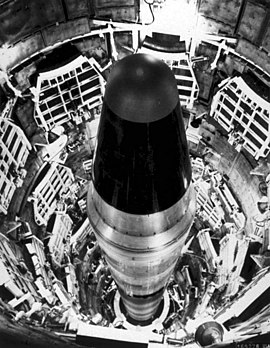LGM-25C Titan II

An LGM-25C Titan intercontinental ballistic missile in silo, ready to launch
|
|
| Function | ICBM/Launch vehicle |
|---|---|
| Manufacturer | Martin |
| Country of origin | United States |
| Cost per launch | $3.16 million (1969) |
| Size | |
| Height | 31.394 m (103.00 ft)(ICBM config) |
| Diameter | 3.05 m (10.0 ft) |
| Mass | 154,000 kg (340,000 lb) |
| Stages | 2 |
| Capacity | |
| Payload to LEO | 3,600 kg (7,900 lb) |
| Payload to 10,000 km (6,200 mi) sub-orbital trajectory |
3,700 kg (8,200 lb) |
| Payload to Polar LEO |
2,177 kg (4,800 lb) |
| Payload to Escape |
227 kg (500 lb) |
| Launch history | |
| Status | Retired |
| Launch sites |
Cape Canaveral LC-15, LC-16 & LC-19 Vandenberg Air Force Base LC-395 & SLC-4E/W |
| Total launches | 106 ICBM: 81 GLV: 12 23G: 13 |
| Successes | 101 ICBM: 77 GLV: 12 23G: 12 |
| Failures | 5 (ICBM: 4, 23G: 1) |
| First flight | 12 March 1962 |
| Last flight | 18 October 2003 |
| Notable payloads |
Gemini (manned) Clementine |
| First stage | |
| Engines | 1 LR-87 |
| Thrust | 1,900 kN (430,000 lbf) |
| Specific impulse | 258 s |
| Burn time | 156 s |
| Fuel | Aerozine 50/dinitrogen tetroxide |
| Second stage | |
| Engines | 1 LR91 liquid-propellant engine |
| Thrust | 445 kN (100,000 lbf) |
| Specific impulse | 316 s |
| Burn time | 180 s |
| Fuel | A-50 Hydrazine/dinitrogen tetroxide |
The Titan II was an intercontinental ballistic missile (ICBM) and space launcher developed by the Glenn L. Martin Company from the earlier Titan I missile. Titan II was originally designed and used as an ICBM, but was later used as a medium-lift space launch vehicle to carry payloads for the United States Air Force (USAF), National Aeronautics and Space Administration (NASA) and National Oceanic and Atmospheric Administration (NOAA). Those payloads included the USAF Defense Meteorological Satellite Program (DMSP), the NOAA weather satellites, and NASA's Gemini manned space capsules. The modified Titan II SLVs (Space Launch Vehicles) were launched from Vandenberg Air Force Base, California up until 2003.
The Titan II ICBM was the successor to the Titan I, with double the payload. Unlike the Titan I, it used hydrazine-based hypergolic propellant which was storable and reliably ignited. This reduced time to launch and permitted it to be launched from its silo. Titan II carried the largest single warhead of any American ICBM.
The missile consists of a two-stage, rocket engine powered vehicle and a re-entry vehicle (RV). Provisions are included for in-flight separation of Stage II from Stage I, and separation of the RV from Stage II. Stage I and Stage II vehicles each contain propellant and pressurization, rocket engine, hydraulic and electrical systems, and explosive components. In addition, Stage II contains the flight control system and missile guidance set.
The airframe is a two-stage, aerodynamically stable structure that houses and protects the airborne missile equipment during powered flight. The missile guidance system enables the shutdown and staging enable relay to initiate Stage I separation. Each stage is 10 feet (3.0 m) in diameter and has fuel and oxidizer tanks in tandem, with the walls of the tanks forming the skin of the missile in those areas. External conduits are attached to the outside surface of the tanks to provide passage for the wire bundles and tubing. Access doors are provided on the missile forward, aft and between-tanks structure for inspection and maintenance. A man-hole cover for tank entry is located on the forward dome of each tank.
...
Wikipedia
